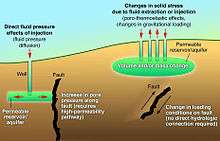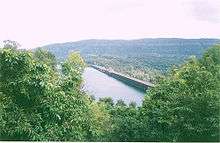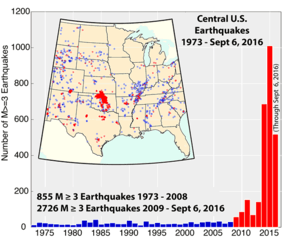Induced seismicity
| Part of a series on |
| Earthquakes |
|---|
| Types |
|
|
| Causes |
| Characteristics |
|
|
| Measurement |
| Prediction |
|
|
| Other topics |
|
Earth Sciences Portal Category • Related topics |
Induced seismicity refers to typically minor earthquakes and tremors that are caused by human activity that alters the stresses and strains on the Earth's crust. Most induced seismicity is of a low magnitude. A few sites regularly have larger quakes, such as The Geysers geothermal plant in California which averaged two M4 events and 15 M3 events every year from 2004 to 2009.[1] Results of ongoing multi-year research on induced earthquakes by the United States Geological Survey (USGS) published in 2015 suggested that most of the significant earthquakes in Oklahoma, such as the 1952 magnitude 5.7 El Reno earthquake may have been induced by deep injection of waste water by the oil industry. "Earthquake rates have recently increased markedly in multiple areas of the Central and Eastern United States (CEUS), especially since 2010, and scientific studies have linked the majority of this increased activity to wastewater injection in deep disposal wells."[2][3][4][5][6][7]:2[8]
Causes

There are many ways in which induced seismicity has been seen to occur. In the past several years, some energy technologies that inject or extract fluid from the Earth, such as oil and gas extraction and geothermal energy development, have been found or suspected to cause seismic events. Some energy technologies also produce wastes that may be managed through disposal or storage by injection deep into the ground. For example, waste water from oil and gas production and carbon dioxide from a variety of industrial processes may be managed through underground injection.
Artificial lakes
The column of water in a large and deep artificial lake alters in-situ stress along an existing fault or fracture. In these reservoirs, the weight of the water column can significantly change the stress on an underlying fault or fracture by increasing the total stress through direct loading, or decreasing the effective stress through the increased pore water pressure. This significant change in stress can lead to sudden movement along the fault or fracture, resulting in an earthquake.[9] Reservoir-induced seismic events can be relatively large compared to other forms of induced seismicity. Though understanding of reservoir-induced seismic activity is very limited, it has been noted that seismicity appears to occur on dams with heights larger than 330 feet (100 m). The extra water pressure created by large reservoirs is the most accepted explanation for the seismic activity.[10] When the reservoirs are filled or drained, induced seismicity can occur immediately or with a small time lag.
The first case of reservoir-induced seismicity occurred in 1932 in Algeria’s Oued Fodda Dam.

The 6.3 magnitude 1967 Koynanagar earthquake occurred in Maharashtra, India with its epicenter, fore- and aftershocks all located near or under the Koyna Dam reservoir.[11] 180 people died and 1,500 were left injured. The effects of the earthquake were felt 140 mi (230 km) away in Bombay with tremors and power outages.
During the beginnings of the Vajont Dam in Italy, there were seismic shocks recorded during its initial fill. After a landslide almost filled the reservoir in 1963, causing a massive flooding and around 2,000 deaths, it was drained and consequently seismic activity was almost non-existent.
On August 1, 1975, a magnitude 6.1 earthquake at Oroville, California, was attributed to seismicity from a large earth-fill dam and reservoir recently constructed and filled.
The filling of the Katse Dam in Lesotho, and the Nurek Dam in Tajikistan is an example.[12] In Zambia, Kariba Lake may have provoked similar effects.
The 2008 Sichuan earthquake, which caused approximately 68,000 deaths, is another possible example. An article in Science suggested that the construction and filling of the Zipingpu Dam may have triggered the earthquake.[13][14][15]
Some experts worry that the Three Gorges Dam in China may cause an increase in the frequency and intensity of earthquakes.[16]
Mining
Mining leaves voids that generally alter the balance of forces in the rock, many times causing rock bursts. These voids may collapse producing seismic waves and in some cases reactivate existing faults causing minor earthquakes.[17] Natural cavern collapse forming sinkholes would produce an essentially identical local seismic event.
Waste disposal wells

Injecting liquids into waste disposal wells, most commonly in disposing of produced water from oil and natural gas wells, has been known to cause earthquakes. This high-saline water is usually pumped into salt water disposal (SWD) wells. The resulting increase in subsurface pore pressure can trigger movement along faults, resulting in earthquakes.[18][19]
The 2011 Oklahoma earthquake near Prague, of magnitude 5.8,[20] occurred after 20 years of injecting waste water into porous deep formations at increasing pressures and saturation.[21] On September 3, 2016, an even stronger earthquake with a magnitude of 5.8 occurred near Pawnee, Oklahoma, followed by nine aftershocks between magnitudes 2.6 and 3.6 within 3 1/2 hours. Tremors were felt as far away as Memphis, Tennessee, and Gilbert, Arizona. Mary Fallin, the Oklahoma governor, declared a local emergency and shutdown orders for local disposal wells were ordered by the Oklahoma Corporation Commission.[22][23] Results of ongoing multi-year research on induced earthquakes by the United States Geological Survey (USGS) published in 2015 suggested that most of the significant earthquakes in Oklahoma, such as the 1952 magnitude 5.5 El Reno earthquake may have been induced by deep injection of waste water by the oil industry.[2] Prior to April 2015 however, the Oklahoma Geological Survey's position was that the quake was most likely due to natural causes and was not triggered by waste injection.[24] This was one of many earthquakes which have affected the Oklahoma region.
Since 2009 earthquakes have become hundreds of time more common in Oklahoma with magnitude 3 events increasing from 1 or 2 per year to 1 or 2 per day.[25] On April 21, 2015, the Oklahoma Geological Survey released a statement reversing its stance on induced earthquakes in Oklahoma: "The OGS considers it very likely that the majority of recent earthquakes, particularly those in central and north-central Oklahoma, are triggered by the injection of produced water in disposal wells."[26]
Extraction of fossil fuels
Large-scale fossil fuel extraction can generate earthquakes.[27][28]
Groundwater extraction
The changes in crustal stress patterns caused by the large scale extraction of groundwater has been shown to trigger earthquakes, as in the case of the 2011 Lorca earthquake.[29]
Geothermal energy
Enhanced geothermal systems (EGS), a new type of geothermal power technologies that do not require natural convective hydrothermal resources, are known to be associated with induced seismicity. EGS involves pumping fluids at pressure to enhance or create permeability through the use of hydraulic fracturing techniques. Hot dry rock (HDR) EGS actively creates geothermal resources through hydraulic stimulation. Depending on the rock properties, and on injection pressures and fluid volume, the reservoir rock may respond with tensile failure, as is common in the oil and gas industry, or with shear failure of the rock's existing joint set, as is thought to be the main mechanism of reservoir growth in EGS efforts.[30]
HDR and EGS systems are currently being developed and tested in Soultz-sous-Forêts (France), Desert Peak and the Geysers (U.S.), Landau (Germany), and Paralana and Cooper Basin (Australia). Induced seismicity events at the Geysers geothermal field in California has been strongly correlated with injection data.[31] The test site at Basel, Switzerland, has been shut down due to induced seismic events.
| Site | Maximum Magnitude |
|---|---|
| Cerro Prieto, Baja California, Mexico[33] | 6.6 |
| The Geysers, United States | 4.6 |
| Cooper Basin, Australia | 3.7 |
| Basel, Switzerland | 3.4 |
| Rosemanowes Quarry, United Kingdom | 3.1 |
| Soultz-sous-Forêts, France | 2.9 |
Researchers at MIT believe that seismicity associated with hydraulic stimulation can be mitigated and controlled through predictive siting and other techniques. With appropriate management, the number and magnitude of induced seismic events can be decreased, significantly reducing the probability of a damaging seismic event.[34]
Induced seismicity in Basel led to suspension of its HDR project. A seismic hazard evaluation was then conducted, which resulted in the cancellation of the project in December 2009.
Hydraulic fracturing
Hydraulic fracturing is a technique in which high-pressure fluid is injected into the low-permeable reservoir rocks in order to induce fractures to increase hydrocarbon production. This process usually generates seismic events that are too small to be felt at the surface (with magnitudes ranging from -3 to 0), although several cases of larger magnitude events (M > 4) have been recorded in Canada in the unconventional resources of Alberta and British Columbia.
U.S. National Research Council report
A 2012 report from the U.S. National Research Council examined the potential for energy technologies—including shale gas recovery, carbon capture and storage, geothermal energy production, and conventional oil and gas development—to cause earthquakes.[35] The report found that only a very small fraction of injection and extraction activities among the hundreds of thousands of energy development sites in the United States have induced seismicity at levels noticeable to the public. However, although scientists understand the general mechanisms that induce seismic events, they are unable to accurately predict the magnitude or occurrence of these earthquakes due to insufficient information about the natural rock systems and a lack of validated predictive models at specific energy development sites.[36]
The report noted that hydraulic fracturing has a low risk for inducing earthquakes that can be felt by people, but underground injection of wastewater produced by hydraulic fracturing and other energy technologies has a higher risk of causing such earthquakes. In addition, carbon capture and storage—a technology for storing excess carbon dioxide underground—may have the potential for inducing seismic events, because significant volumes of fluids are injected underground over long periods of time.[36]
References
- ↑ "Man-made geothermal earthquakes". Anderson Springs Community Alliance. 2009. Retrieved April 28, 2016.
- 1 2 Hough, Susan E.; Page, Morgan (October 20, 2015). "A Century of Induced Earthquakes in Oklahoma?". U.S. Geological Survey. Retrieved November 8, 2015.
Several lines of evidence further suggest that most of the significant earthquakes in Oklahoma during the 20th century may also have been induced by oil production activities. Deep injection of waste water, now recognized to potentially induce earthquakes, in fact began in the state in the 1930s.
- ↑ Ellsworth, W.L. (2013). "Injection-induced earthquakes". Science. 341 (6142): 7. doi:10.1126/science.1225942.
- ↑ Keranen, K.M.; Weingarten, Matthew; Abers, G.A.; Bekins, B.A.; Ge, Shemin (2014). "Sharp increase in central Oklahoma seismicity since 2008 induced by massive wastewater injection". Science. 345 (6195): 448–451. doi:10.1126/science.1255802.
- ↑ Walsh, F.R.; Zoback, M.D. (2015). "Oklahoma's recent earthquakes and saltwater disposal". Science Advances. 1 (5): e1500195. doi:10.1126/sciadv.1500195.
- ↑ Weingarten, Matthew; Ge, Shemin; Godt, J.W.; Bekins, B.A.; Rubinstein, J.L. (2015). "High-rate injection is associated with the increase in U.S. mid-continent seismicity". Science. 348 (6241): 1336–1340. doi:10.1126/science.aab1345.
- ↑ Petersen, Mark D.; Mueller, Charles S.; Moschetti, Morgan P.; Hoover, Susan M.; Llenos, Andrea L.; Ellsworth, William L.; Michael, Andrew J.; Rubinstein, Justin L.; McGarr, Arthur F.; Rukstales, Kenneth S. (April 1, 2016). 2016 One-Year Seismic Hazard Forecast for the Central and Eastern United States from Induced and Natural Earthquakes (PDF) (Report). Reston, Virginia. p. 58. doi:10.3133/ofr20161035. ISSN 2331-1258.
- ↑ Keranen, Katie M.; Savage, Heather M.; Abers, Geoffrey A.; Cochran, Elizabeth S. (2013). "Potentially induced earthquakes in Oklahoma, USA: Links between wastewater injection and the 2011 Mw 5.7 earthquake sequence". Geology. 41: 699–702. doi:10.1130/G34045.1. Retrieved April 28, 2016.via EBSCO
- ↑ Simpson, D. W.; Leith, W. S.; Schcolz, C.H. (1988). "Two Types of Reservoir-Induced Seismicity". Bulletin of the Seismological Society of America. 78 (6): 2025–2040.
- ↑ http://internationalrivers.org/de/node/1477
- ↑ Reservoir-Induced Seismicity
- ↑ International Rivers
- ↑ "A Human Trigger for the Great Quake of Sichuan?". Science. 323: 322. 2009. doi:10.1126/science.323.5912.322.
- ↑ Chinese earthquake may have been man-made, say scientists, Telegraph, February 3, 2009
- ↑ Naik, Gautam; Oster, Shai (February 6, 2009). "Scientists Link China's Dam to Earthquake, Renewing Debate". The Wall Street Journal.
- ↑ Chen, L.; Talwani, P. (1998). "Seismicity in China". Pure and Applied Geophysics. 153: 133–149. doi:10.1007/s000240050188.
- ↑ Redmayne, D.W. (1988) Mining induced seismicity in UK coalfields identified on the BGS National Seismograph Network. Geological Society, London, Engineering Geology Special Publications; vol. 5; pp. 405-413
- ↑ http://bssa.geoscienceworld.org/cgi/content/abstract/101/1/327
- ↑ Madrigal, Alexis (June 4, 2008). "Top 5 Ways to Cause a Man-Made Earthquake". Wired.
- ↑ U.S. Geological Survey, Oklahoma - Magnitude 5.8.
- ↑ Henry Fountain (March 28, 2013). "Study Links 2011 Quake to Technique at Oil Wells". The New York Times. Retrieved March 29, 2013.
- ↑ Record tying Oklahoma earthquake felt as far away as Arizona, Associated Press, Ken Miller, September 3, 2016. Retrieved 3 September 2016.
- ↑ USGS calls for shut down of wells, governor declares emergency in wake of 5.6 quake in Oklahoma, Enid News & Eagle, Sally Asher & Violet Hassler, September 3, 2016. Retrieved 4 September 2016.
- ↑ Keller, G. Randy; Holland, Austin A. (March 22, 2013). Statement about the cause of 2011 Prague Earthquake Sequence (PDF). Oklahoma Geological Survey (Report). Retrieved April 30, 2015.
- ↑ Pérez-Peña, Richard (April 23, 2015). "U.S. Maps Pinpoint Earthquakes Linked to Quest for Oil and Gas". New York Times. Retrieved November 8, 2015.
- ↑ Andrews, Richard D.; Holland, Austin A. (April 21, 2015). Statement on Oklahoma Seismicity (PDF). Oklahoma Geological Survey (Report). University of Oklahoma. Retrieved April 30, 2015.
- ↑ http://esd.lbl.gov/research/projects/induced_seismicity/oil&gas/
- ↑ Van Eijsa, R.M.H.E; Muldersa, F.M.M; Nepveua, M; Kenterb, C.J; Scheffers, B.C. (2006). "Correlation between hydrocarbon reservoir properties and induced seismicity in the Netherlands". Engineering Geology. 84: 99–111. doi:10.1016/j.enggeo.2006.01.002.
- ↑ González, P.J.; Tiampo K.F.; Palano M.; Cannavó F.; Fernández J. (2012). "The 2011 Lorca earthquake slip distribution controlled by groundwater crustal unloading". Nature Geoscience. 5: 821–825. doi:10.1038/ngeo1610. Retrieved 1 November 2012.
- ↑ Tester, Jefferson W. (Massachusetts Institute of Technology); et al. (2006). The Future of Geothermal Energy - Impact of Enhanced Geothermal Systems (EGS) on the United States in the 21st Century (14MB PDF). Idaho Falls: Idaho National Laboratory. pp. 4–10. ISBN 0-615-13438-6. Retrieved 2007-02-07.
- ↑ http://escholarship.org/uc/item/0t19709v The Impact of Injection on Seismicity at The Geysers Geothermal Field
- ↑ Bromley, C.J. & Mongillo, M.A. (February 2007), "All Geothermal Energy from Fractured Reservoirs - Dealing with Induced Seismicity" (PDF), IEA Open Journal, 48 (7): 5
- ↑ http://www.bssaonline.org/cgi/content/abstract/86/1A/93 Major earthquakes in Mexicali Valley, Mexico, and fluid extraction at Cerro Prieto Geothermal Field
- ↑ Tester 2006, pp. 5–6
- ↑ U.S. National Research Council Report, Induced Seismicity Potential in Energy Technologies, http://dels.nas.edu/Report/Induced-Seismicity-Potential-Energy-Technologies/13355
- 1 2 U.S. National Research Council Report-in-Brief, Induced Seismicity Potential in Energy Technologies, http://dels.nas.edu/Materials/Report-In-Brief/4298-Induced-Seismicity
Further reading
- Kisslinger, C (1976). "A review of theories of mechanisms of induced seismicity". Engineering Geology. 10 (2-4): 85–98. doi:10.1016/0013-7952(76)90014-4. ISSN 0013-7952.
- Talwani, P. (1997). "On the Nature of Reservoir-induced Seismicity". Pure and Applied Geophysics. 150 (3-4): 473–492. Bibcode:1997PApGe.150..473T. doi:10.1007/s000240050089. ISSN 0033-4553.
External links
- Map of reservoir-induced earthquakes at International Rivers
- WEBINAR: Yes, Humans Really Are Causing Earthquakes – IRIS Consortium
- One-year seismic hazard forecast for the Central and Eastern United States from induced and natural earthquakes - United States Geological Survey, 2016 (with maps)
- Induced Earthquakes - United States Geological Survey site